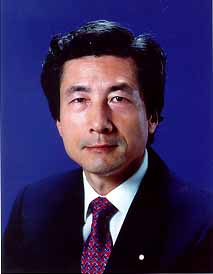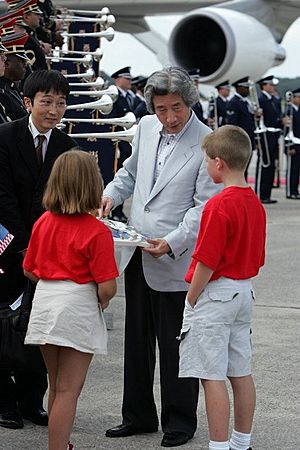Junichiro Koizumi facts for kids
Quick facts for kids
Junichiro Koizumi
|
|
|---|---|
|
小泉 純一郎
|
|
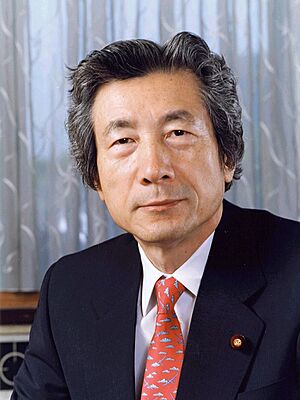
Official portrait, 2001
|
|
| Prime Minister of Japan | |
| In office 26 April 2001 – 26 September 2006 |
|
| Monarch | Akihito |
| Preceded by | Yoshirō Mori |
| Succeeded by | Shinzo Abe |
| President of the Liberal Democratic Party | |
| In office 20 April 2001 – 20 September 2006 |
|
| Vice President | Taku Yamasaki |
| Secretary-General |
|
| Preceded by | Yoshirō Mori |
| Succeeded by | Shinzo Abe |
| Minister of Health and Welfare | |
| In office 7 November 1996 – 29 July 1998 |
|
| Prime Minister | Ryutaro Hashimoto |
| Preceded by | Naoto Kan |
| Succeeded by | Sohei Miyashita |
| In office 27 December 1988 – 10 August 1989 |
|
| Prime Minister | |
| Preceded by | Takao Fujimoto |
| Succeeded by | Saburo Toida |
| Minister of Post and Telecommunications | |
| In office 12 December 1992 – 20 July 1993 |
|
| Prime Minister | Kiichi Miyazawa |
| Preceded by | Hideo Watanabe |
| Succeeded by | Kiichi Miyazawa |
|
|
| In office 10 December 1972 – 21 July 2009 |
|
| Preceded by | Multi-member district |
| Succeeded by | Shinjirō Koizumi |
| Constituency |
|
| Personal details | |
| Born | 8 January 1942 Yokosuka, Japan |
| Political party | Liberal Democratic |
| Spouse |
Kayoko Miyamoto
(m. 1978; div. 1982) |
| Children |
|
| Parents | Jun'ya Koizumi (father) Yoshie Koizumi (mother) |
| Relatives | Koizumi Matajirō (grandfather) |
| Alma mater | |
Junichiro Koizumi (born January 8, 1942) is a Japanese politician who used to be the Prime Minister of Japan. He led the country and the Liberal Democratic Party (LDP) from 2001 to 2006. He stopped being involved in politics in 2009. He is known as one of Japan's longest-serving Prime Ministers.
When he became leader in 2001, Koizumi was seen as a unique figure in the LDP. He focused on changing Japan's economy. He worked to reduce the country's government debt and made the postal service a private company. In the 2005 election, Koizumi helped the LDP win a huge number of seats in parliament.
Koizumi also gained international attention. He sent Japan's military, called the Japan Self-Defense Forces, to Iraq. His visits to the Yasukuni Shrine caused some tension with nearby countries like China and South Korea. Koizumi stepped down as prime minister in 2006.
After leaving office, Koizumi kept a low profile for several years. However, in 2013, he spoke out about wanting Japan to stop using nuclear power in Japan. This was after the 2011 Fukushima nuclear disaster. His new view was different from the LDP's usual support for nuclear power.
Contents
Early Life and Family History
Junichiro Koizumi comes from a family of politicians. His father, Jun'ya Koizumi, was in charge of Japan's defense and a member of parliament. His grandfather, Koizumi Matajirō, was also a minister. He was known for supporting the idea of making the postal service private a long time ago.
Koizumi was born in Yokosuka, Kanagawa, on January 8, 1942. He went to Yokosuka High School and then studied economics at Keio University. He also studied in London before returning to Japan in 1969 when his father passed away.
He tried to get elected to parliament in 1969 but didn't win enough votes. In 1970, he became a secretary for Takeo Fukuda, who later became prime minister. In 1972, Koizumi was elected to parliament, taking over the seat his father used to hold. He was re-elected ten times after that.
Becoming a Member of Parliament
Koizumi got his first important job in 1979, working for the Ministry of Finance. In 1988, he became the Minister of Health and Welfare. He held other cabinet jobs later, including Minister of Posts and Telecommunications in 1992 and Minister of Health and Welfare again from 1996 to 1998.
In 1994, Koizumi joined a new group within the LDP called Shinseiki. This group included younger, energetic politicians like Taku Yamasaki and Koichi Kato. They were often called "YKK" after a famous zipper company.
Koizumi tried to become the leader of the LDP in 1995 and 1998 but didn't win. However, after some political challenges faced by Yamasaki and Kato in 2000, Koizumi became the most important member of the "YKK" group who wanted to see changes in the party.
On April 24, 2001, Koizumi was elected president of the LDP. Many thought he was an unlikely choice. But he won by a large margin against Ryutaro Hashimoto. He became the Prime Minister of Japan on April 26, 2001. His party and its allies won many seats in the parliament elections that July.
Leading Japan as Prime Minister
Changes at Home
As prime minister, Koizumi wanted to make Japan's economy stronger. He worked to fix problems with bank debts and to make the postal savings system a private company. He believed that Japan needed to go through some tough changes to have a better future. He created a new group called the Council on Economic and Fiscal Policy to help plan these changes.
In 2002, Koizumi appointed Heizō Takenaka to help solve the country's banking crisis. They managed to greatly reduce the amount of bad debt held by banks. Japan's economy slowly started to get better, and the stock market improved. In 2004, Japan's economy grew faster than many other major countries. Takenaka also helped with the plan to privatize Japan Post.
Koizumi also changed the LDP's focus. The party used to rely heavily on support from rural areas. But Koizumi shifted the party more towards urban areas and new economic ideas. He also reduced government spending on big projects in rural areas. These changes made him a popular but sometimes controversial leader within his own party.
Foreign Relations
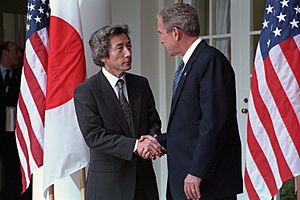
Koizumi's foreign policy focused on having a strong relationship with the United States. He supported the US in the fight against terrorism. He decided to send Japan's military, the Japan Self-Defense Forces, to Iraq. This was the first time Japanese troops were sent to an active war zone since World War II. Many people believed that Koizumi's good relationship with US President George W. Bush helped strengthen ties between the two countries. They even played baseball together! After leaving office, Koizumi continued to defend his decision to send troops to Iraq.
Koizumi also took a stronger stance on issues with North Korea, especially regarding Japanese citizens who had been taken and North Korea's nuclear weapons program.
Military Policy
Koizumi supported making the Japan Self-Defense Forces stronger and allowing them to operate more outside of Japan. In October 2001, some Japanese troops were sent to Iraq. His government also worked to change the Defense Agency into a full ministry, which happened in 2007.
Visits to Yasukuni Shrine
Koizumi's visits to the Yasukuni Shrine were often talked about. He visited the shrine six times while he was prime minister. This shrine honors Japanese people who died in wars, including some who were found responsible for serious wartime actions. These visits caused strong protests and anger from Japan's neighbors, especially China and South Korea. People in these countries remember Japan's actions during the first half of the 20th century.
Because of these visits, leaders from China and South Korea refused to meet Koizumi in Japan. There were no official visits between Chinese and Japanese leaders from 2001 to 2006, and between South Korean and Japanese leaders from 2005 to 2006. This changed when the next prime minister, Shinzo Abe, visited China and South Korea.
In China, Koizumi's visits led to large protests. In South Korea, the president and many media outlets openly criticized his visits. Koizumi said his visits were personal, not political. However, many people, including some in Japan, questioned this, especially since he signed the shrine's guestbook as "Prime Minister of Japan." He visited the shrine every year because he had promised to do so during his election campaign. His last visit as prime minister was on August 15, 2006, the anniversary of Japan's surrender in World War II.
Even after he stopped being prime minister, Koizumi visited the shrine again on August 15, 2007. This visit received less attention than his earlier ones.
Statements on World War II
On August 15, 2005, the 60th anniversary of the end of World War II, Koizumi publicly said, "I would like to express keen remorse and heartfelt apologies." He promised that Japan would never again choose "the path to war."
Popularity
Koizumi was very popular at times during his time in office. People liked his direct way of speaking. He was sometimes called "Lionheart" or "Maverick." The Japanese public even called him Jun-chan, a friendly nickname. In June 2001, about 80% of people approved of him.
In January 2002, Koizumi fired his Foreign Minister, Makiko Tanaka, who was also very popular. After an economic slowdown and some scandals in his party, Koizumi's popularity dropped.
He was re-elected in 2003, and his popularity went up as the economy improved. However, his plan to cut pension benefits was not very popular. He visited North Korea twice to try and bring back Japanese citizens who had been taken, which helped his popularity a little. In the 2004 elections for the upper house of parliament, his party only did slightly better than the main opposition party.
In 2005, the upper house of parliament rejected his plan to privatize the postal service. Koizumi had said he would call for new elections if the plan failed. Many members of his own party also voted against the plan or didn't vote at all.
On August 8, 2005, Koizumi kept his promise and dissolved the lower house of parliament, calling for new elections. He even removed LDP members who didn't support his postal service plan. His popularity then jumped by almost 20 points. People saw the election as a vote for or against his reforms.
The September 2005 elections were a huge victory for the LDP. They won a large majority in parliament. This allowed Koizumi to pass 82 of his 91 proposed laws, including the postal privatization bill. Many new politicians who supported Koizumi, known as "Koizumi Children", joined parliament after this election.
Life After Politics
Koizumi had announced that he would step down in 2006, following LDP rules. He did not choose his successor. On September 20, 2006, Shinzo Abe was chosen to take over as LDP president. Abe then became prime minister on September 26, 2006.
Koizumi remained a member of parliament for a few more years. On September 25, 2008, he announced he was retiring from politics. He kept his seat until the next election in 2009. His son, Shinjirō Koizumi, was then elected to the same seat.
Since leaving the prime minister's office, Koizumi has mostly stayed out of the public eye. He has not given any interviews on TV, though he has given some speeches.
Speaking Out Against Nuclear Power
Koizumi returned to public attention in October 2013. After years of quiet, he gave a speech saying, "We should aim to be nuclear-free." He believed that if the LDP supported a zero-nuclear policy, many people would agree. He talked about how Japan rebuilt after World War II and suggested the country should work towards using only renewable energy.
This was a big change for Koizumi, as he had supported nuclear power when he was prime minister. He was one of the first pro-nuclear politicians to change his mind after the Fukushima Daiichi nuclear disaster in 2011. His strong words were widely reported in Japan. Some people even wondered if he might leave the LDP to start a new party with his son.
Koizumi defended his new view. He said it was "irresponsible" to think nuclear power plants could be maintained easily. He believed it was better to spend money on developing natural energy sources. He explained that he had visited a nuclear waste site in Finland and learned that nuclear waste needs to be stored safely for 100,000 years. A poll in November 2013 showed that 54% of the public supported Koizumi's anti-nuclear statements. He told a reporter that he felt misled by power companies that said nuclear power was safe.
Koizumi encouraged Morihiro Hosokawa, another former prime minister, to run for Governor of Tokyo in the February 2014 election. They both campaigned against the government's pro-nuclear policy. Hosokawa lost the election, but Koizumi and Hosokawa continued to work together, organizing an anti-nuclear meeting in May 2014.
In 2016, Koizumi traveled to the United States to support a lawsuit. This lawsuit was brought by people who were part of Operation Tomodachi and claimed they got sick from radiation exposure after the Fukushima disaster.
Personal Life
Koizumi lives in Yokosuka, Kanagawa.
Family Life
Koizumi married Kayoko Miyamoto in 1978 when she was 21. Their wedding was a big event with about 2,500 guests, including the prime minister at the time. The marriage ended in divorce in 1982. Koizumi never married again, saying that divorce took much more energy than marriage.
Koizumi raised two of his three sons: Kōtarō Koizumi and Shinjirō Koizumi. His sister helped raise them. Shinjiro is now a member of parliament, just like his father. Kotaro is an actor. Koizumi's youngest son, Yoshinaga Miyamoto, was born after the divorce and did not meet his father for many years. Yoshinaga finally met his father and brothers in 2010. Koizumi and his two older sons also attended Yoshinaga's wedding in 2013.
Koizumi has a cousin in Brazil. He was very moved when he visited Brazil in 2004 and met a group of Japanese immigrants there.
Hobbies and Interests
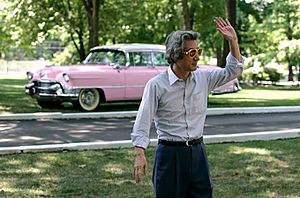
Koizumi enjoys the music of German composer Richard Wagner. He also released a CD of his favorite songs by Italian composer Ennio Morricone. He is a fan of the rock band X Japan. The LDP even used their song "Forever Love" in TV ads in 2001.
Koizumi is also a big fan of Elvis Presley. They share the same birthday, January 8. In 2001, Koizumi released a CD of his favorite Presley songs. His brother is a senior advisor for the Tokyo Elvis Presley Fan Club. Koizumi and his brother helped pay for a statue of Presley in Tokyo. On June 30, 2006, Koizumi visited Presley's home, Graceland, with U.S. President George W. Bush. While there, Koizumi sang some of his favorite Presley songs and even wore Presley's large golden sunglasses.
He also likes Finnish composer Jean Sibelius. In 2006, he visited Sibelius's home in Finland and showed his respect for the composer.
In 2009, Koizumi used his voice in a movie called Mega Monster Battle: Ultra Galaxy Legend The Movie, playing the voice of Ultraman King. He said his son Shinjiro encouraged him to take the role. His political life is also made fun of in a Japanese comic book series called Mudazumo Naki Kaikaku, where he is shown as a master of the game mahjong.
People have often compared him to American actor Richard Gere because of their similar hairstyles. In 2005, he even did an "impromptu ballroom dance performance" with Richard Gere to boost his popularity.
Koizumi's Cabinets
| First (26 April 2001) |
First, Realigned (30 September 2002) |
Second (19 November 2003) |
Second, Realigned (22 September 2004) |
Third, Realigned (31 October 2005) |
|
|---|---|---|---|---|---|
| Secretary | Yasuo Fukuda 4 | Hiroyuki Hosoda | Shinzō Abe | ||
| Internal Affairs | Toranosuke Katayama | Taro Aso | Heizō Takenaka 3 | ||
| Justice | Mayumi Moriyama | Daizō Nozawa | Chieko Nohno | Seiken Sugiura | |
| Foreign Affairs | Makiko Tanaka 1 | Yoriko Kawaguchi | Nobutaka Machimura | Taro Aso | |
| Finance | Masajuro Shiokawa | Sadakazu Tanigaki | |||
| Education | Fumio Kishida | Takeo Kawamura | Nariaki Nakayama | Kenji Kosaka | |
| Health | Chikara Sakaguchi | Hidehisa Otsuji | Jirō Kawasaki | ||
| Agriculture | Tsutomu Takebe | Tadamori Oshima 2 | Yoshiyuki Kamei | Yoshinobu Shimamura | Shoichi Nakagawa |
| Economy | Takeo Hiranuma | Shōichi Nakagawa | Toshihiro Nikai | ||
| Land | Chikage Oogi | Nobuteru Ishihara | Kazuo Kitagawa | ||
| Environment | Hiroshi Oki 1 | Shunichi Suzuki | Yuriko Koike | ||
| Public Safety | Jin Murai | Sadakazu Tanigaki | Kiyoko Ono | Yoshitaka Murata | Tetsuo Kutsukake |
| Disaster Prevention | Yoshitada Konoike | Kiichi Inoue | |||
| Defense | Gen Nakatani | Shigeru Ishiba | Yoshinori Ohno | Fukushiro Nukaga | |
| Economic Policy | Heizō Takenaka 3 | Heizō Takenaka | Heizō Takenaka | Kaoru Yosano | |
| Financial Affairs | Hakuo Yanagisawa | Tatsuya Ito | |||
| Admin. and Reg. Reform | Nobuteru Ishihara | Kazuyoshi Kaneko | Seiichiro Murakami | Kōki Chūma | |
| Technology | Koji Omi | Hiroyuki Hosoda | Toshimitsu Motegi | Yasufumi Tanahashi | Iwao Matsuda |
| Youth and Gender | Kuniko Inoguchi | ||||
Notes:
- Makiko Tanaka was removed from her position on January 29, 2002. Koizumi temporarily served as foreign minister until February 1, when he appointed Yoriko Kawaguchi to the role. Koizumi then appointed Hiroshi Oki to replace Kawaguchi.
- Oshima resigned on March 31, 2003, due to a farm-subsidy issue. He was replaced by Kamei, who stayed in the next cabinet change.
- Takenaka also held the job of Minister of State for Postal Privatization since Koizumi's first cabinet. He is the only person to serve in Koizumi's cabinet through all five changes.
- Fukuda resigned on May 7, 2004, and was replaced by Hosoda.
See also
 In Spanish: Jun'ichirō Koizumi para niños
In Spanish: Jun'ichirō Koizumi para niños
- List of prime ministers of Japan
- First Koizumi Cabinet
- Second Koizumi Cabinet
- Third Koizumi Cabinet


